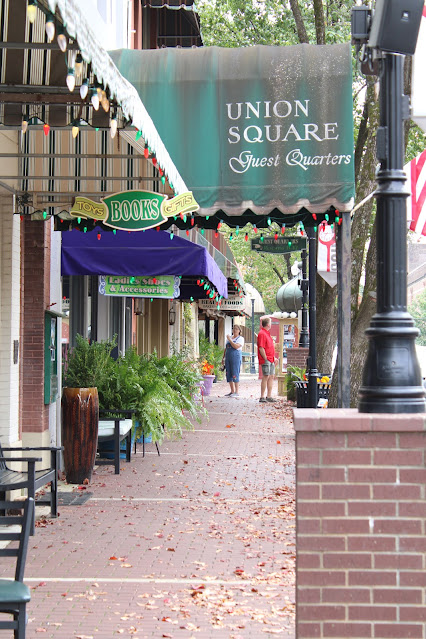This past week my travels lead me to the town of El Dorado in south central Arkansas. My time there was limited but I did manage to spend some time in the city's rather charming downtown area. Overall the city of El Dorado is pretty atypical in regards to most locations throughout the region meaning that there is a lot of poverty and rough neighborhoods so I was surprised to discover an oasis of upscare dining, shopping and entertainment in the old downtown district.
Here is some information from the El Dorado city website:
Nestled near the calm waters of the Ouachita River in the Timberlands region of South Arkansas, El Dorado is undergoing a unique renaissance. Voted as having "America's Best Downtown" in 2009, El Dorado has evolved from a humble oil town into an area rich in southern charm, history and some of the best Arkansas Festivals.The region, like many areas of the South, is filled with some fascinating history. Here is some information from the Encyclopedia of Arkansas website:
Whether it is enjoying the South Arkansas Symphony, trying new vintages at the Southern Food & Wine Festival or watching a reenactment of a historical gun fight on the Union County Courthouse steps, there is always something to do or see here.
From the award-winning MusicFest in the fall to the Mayhaw Festival in the spring, El Dorado is fast becoming known as a premiere entertainment destination. With the creation of El Dorado Festivals & Events, Inc., that reputation is only going to grow bigger, better and stronger. See a list of upcoming Arkansas Festivals.
El Dorado is the county seat of Union County in south central Arkansas and a center for oil production and refining. Called once by boosters the “Queen City of South Arkansas” and, more recently, “Arkansas’s Original Boomtown,” the city was the heart of the 1920s oil boom in South Arkansas.
The city was founded in 1843 when Matthew Rainey set up a retail store in the area. Some reports state that Rainey had become stranded and sold his belongings to tide him over. So impressed with the sales to local settlers, he decided to stay permanently and named the site El Dorado, most often translated as “the Gilded Road” in Spanish. In 1843, El Dorado became the county seat for Union County. First Presbyterian Church, the oldest Presbyterian church in the region, was organized in El Dorado in 1846, with the First Baptist Church organized in 1845.
During the Civil War, Confederate units organized and trained in Union County. In 1864, Confederate units moved through the El Dorado area in order to engage advancing Union troops in the Camden (Ouachita County) area, but El Dorado itself saw no major military action during the conflict.
The community remained an isolated farming community from its founding until the late nineteenth century. The arrival of railroads by the late 1800s allowed business interests to exploit the native resources and build a thriving lumber industry.
Economically, the community remained dependent on agriculture and lumber into the 1920s, limiting its growth. January 10, 1921, changed El Dorado forever with the completion of the Busey No. 1 well. Dr. Samuel T. Busey, a physician and oil speculator, completed the drilling of a well one mile southwest of El Dorado. The “discovery well” touched off a wave of speculators into the area, seeking fame and fortune from oil. The Busey No. 1 well would produce oil for only forty-five days, but El Dorado changed from an isolated agricultural city of approximately 4,000 residents to the oil capital of Arkansas. By 1923, El Dorado boasted fifty-nine oil contracting companies, thirteen oil distributors and refiners, and twenty-two oil production companies. The city was flooded with so many people that no bed space was available for them, leading to whole neighborhoods of tents and hastily constructed shacks to be erected throughout the city. The city’s population reached a high of nearly 30,000 in 1925 during the boom before dropping to 16,241 by 1930 and rising to 25,000 by 1960. - READ MORE
Here is a map of the El Dorado Downtown Historical District:
Here are my photos of a fall day in downtown El Dorado:
Check Out:
































No comments:
Post a Comment